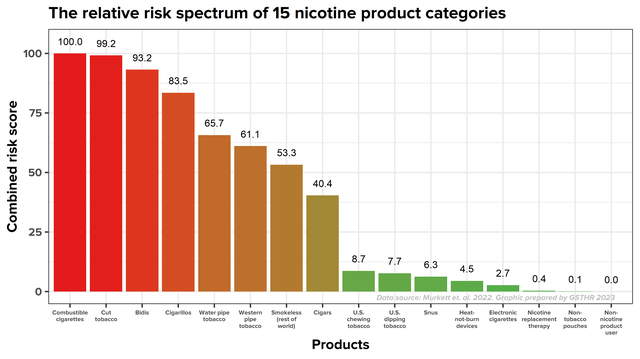Nicotine pouches are thumbnail-sized sachets containing vegetable fibres infused with nicotine and a range of flavours. Placed in the mouth between the lip and gum, nicotine is absorbed through the oral mucous membrane. Well-known brands include Velo (manufactured by BAT), on! (Altria) and ZYN (Swedish Match).
Due to their similar appearance and method of use, nicotine pouches are sometimes confused with Swedish snus, another safer nicotine product (SNP) that is placed between the lip and gum. But while Swedish snus contains tobacco, nicotine pouches do not contain any raw or processed tobacco leaves.
The health impacts of smoking are now well understood to be caused by the combustion of tobacco which produces a cocktail of harmful chemicals found in smoke. But since nicotine pouches contain no tobacco, and require no combustion, their use avoids many of the risks associated with smoking that result from the burning of tobacco.
When compared to other nicotine delivery systems, nicotine pouches are considered to pose an even lower risk to health than snus, a safer nicotine product that has been proven to be a safer alternative to smoking.

The relative risk hierarchy of the 15 categories of nicotine products. Adapted from Murkett et al with permission.
This is supported by research conducted into the relative levels of tobacco-specific nitrosamines (TSNAs) found in both products. These toxicants are carcinogens that are linked to cancers of the lung, oral cavity, liver and oesophagus, but in a study comparing the quantities of toxicants found in Swedish snus and nicotine pouches, it was found that the levels of several TSNAs were measurably lower in nicotine pouches than in Swedish snus. The TSNA concentrations found in nicotine pouches were comparable to those found in oral nicotine replacement therapy.
Nicotine pouches therefore have the potential to make a significant contribution to tobacco harm reduction, which offers people who use high-risk tobacco products, like cigarettes and some oral tobaccos, the chance to switch to safer nicotine products that pose significantly fewer risks to their health.
Nicotine pouches also have the potential to replace risky oral Asian-style smokeless tobacco products such as betel quid, paan or gutkha. Substitution of risky smokeless tobacco with nicotine pouches could help reduce rates of non-communicable disease in numerous low-and middle-income countries where smokeless tobacco use is prevalent.
Overall, nicotine pouches are low-tech and have a low environmental impact as they contain no batteries or other electronic components. The rapid growth of the nicotine pouch market, already worth 1.5bn USD globally, shows users of high-risk tobacco find these products acceptable and are switching to them.
Find out more about nicotine pouches in our Briefing Paper here.